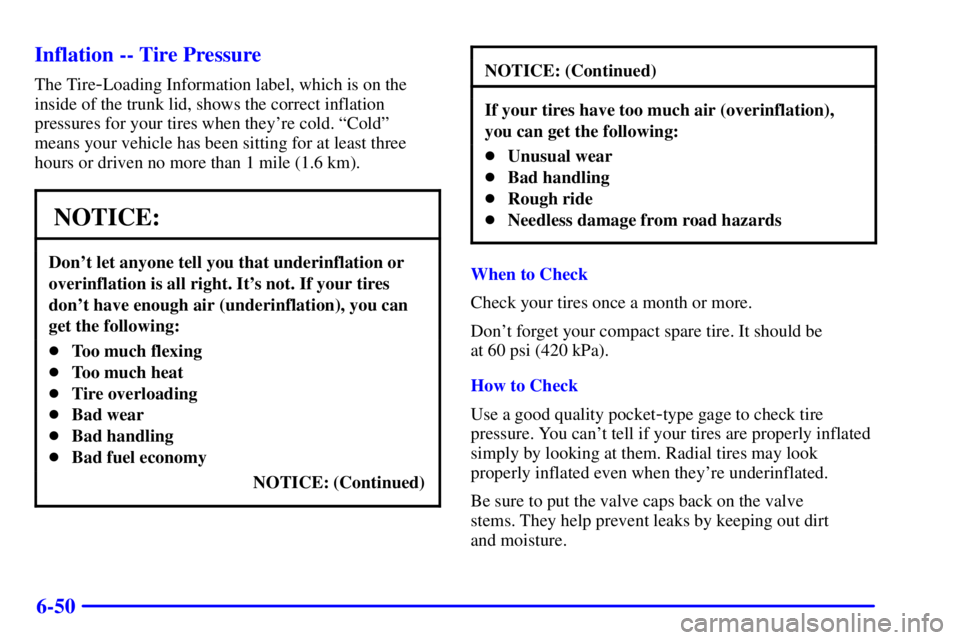Page 306 of 374
6-44
5. Remove the old bulb from the socket.
6. Place the new bulb into the socket.
7. Turn the bulb socket a quarter turn clockwise to
reinstall it.
8. Carefully reinstall the headlamp assembly.
Be careful to avoid scratching or chipping the paint
on the vehicle.
9. Reinstall the two bolts on the top of the
headlamp assembly.
10. Close the hood.
Center High-Mounted Stoplamp (CHMSL)
1. Open the trunk.
2. Reach through the access opening in the trunk and
remove the slotted vent by squeezing the ends and
pulling down.
Page 307 of 374
6-45
3. Remove old the bulb by turning it a quarter
turn counterclockwise.
4. Place the new bulb into the bulb socket.
5. Turn the bulb a quarter turn clockwise. Reinstall
the vent.
6. Close the trunk.
Back-Up, Tail Lamp and Rear Sidemarker
1. Open the trunk.
2. Unhook the convenience net (if equipped) and
remove it.
3. Unscrew the upper convenience net
hook attachment.
4. Pull the trunk trim carpeting away from the rear of
the trunk.
5. Remove the upper trunk trim hook and the
two plastic wing nuts from the taillamp.
Page 312 of 374

6-50 Inflation -- Tire Pressure
The Tire-Loading Information label, which is on the
inside of the trunk lid, shows the correct inflation
pressures for your tires when they're cold. ªColdº
means your vehicle has been sitting for at least three
hours or driven no more than 1 mile (1.6 km).
NOTICE:
Don't let anyone tell you that underinflation or
overinflation is all right. It's not. If your tires
don't have enough air (underinflation), you can
get the following:
�Too much flexing
�Too much heat
�Tire overloading
�Bad wear
�Bad handling
�Bad fuel economy
NOTICE: (Continued)
NOTICE: (Continued)
If your tires have too much air (overinflation),
you can get the following:
�Unusual wear
�Bad handling
�Rough ride
�Needless damage from road hazards
When to Check
Check your tires once a month or more.
Don't forget your compact spare tire. It should be
at 60 psi (420 kPa).
How to Check
Use a good quality pocket
-type gage to check tire
pressure. You can't tell if your tires are properly inflated
simply by looking at them. Radial tires may look
properly inflated even when they're underinflated.
Be sure to put the valve caps back on the valve
stems. They help prevent leaks by keeping out dirt
and moisture.
Page 329 of 374
6-67
Vehicle Identification Number (VIN)
This is the legal identifier for your vehicle. It appears on
a plate in the front corner of the instrument panel, on the
driver's side. You can see it if you look through the
windshield from outside your vehicle. The VIN also
appears on the Vehicle Certification and Service Parts
labels and the certificates of title and registration.
Engine Identification
The 8th character in your VIN is the engine code. This
code will help you identify your engine, specifications
and replacement parts.
Service Parts Identification Label
You'll find this label on the underside of your trunk lid.
It's very helpful if you ever need to order parts. On this
label is:
�your VIN,
�the model designation,
�paint information and
�a list of all production options and
special equipment.
Be sure that this label is not removed from the vehicle.
Page 335 of 374
6-73
Fuse Description
6 Cooling Fan 1
7 Battery Main 1
8 Ignition Main 2
18 Fuel Injections
19 Spare
20 Spare
21 Mass Air Flow (MAF),
Heated Sensors, Canister Purge,
Boost Solenoid
22 Spare
23 Spare
24 Spare
25 Ignition Module
26 Spare
27 Trunk Release, Back
-Up Lamps
28 AC Clutch, ABS Ignition Fuse Description
29 Remote Keyless Entry,
Theft
-Deterrent, Trip Computer,
HVAC Module, Security LED
30 Alt Sense
31 Torque Converter Clutch (TCC)
32 Fuel Pump
33 Electronic Control
Module/Powertrain
Control Module
34 Spare
35 Fog Lamps
36 Horn
37 Chime/Mall Module, Taillamps,
Parking Lamps, Sidemarker
Lamps, Dimmable Lamps
38 Spare Fuse
39 Air Pump
40 Mini Fuse Puller